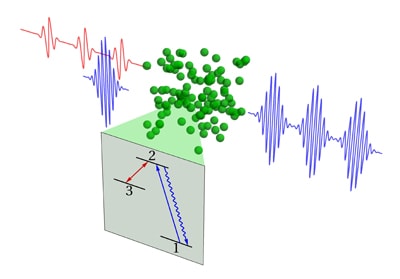
A design for what would be the world’s first X-ray frequency comb has been unveiled by physicists in Germany. The team believes that its comb – which would be used to measure the frequencies of X-rays – can be built using existing technologies. A working device could be used to make fundamental measurements in atomic physics with much greater precision than is possible today. The design could even be extended to produce gamma-ray combs, say the physicists.
Conventional frequency combs are short laser pulses comprising light at a number of well-defined frequencies. When plotted as intensity versus frequency, the light is represented by a series of sharp, equally spaced peaks that together resemble the teeth of a comb. Combs are used as a ruler to measure with great accuracy an unknown frequency relative to a precisely defined reference frequency, such as an atomic clock. Combs can therefore detect tiny changes in the frequency of a light signal that is associated with a physical phenomenon. For example, the gravitational tug of an exoplanet causes a periodic change in the Doppler shift of the light from its companion star’s light.
Combs working at optical frequencies were first developed in the 1990s by John Hall at the JILA Lab in Boulder, Colorado, and Theodor Hänsch at Ludwig Maximilians University in Munich, Germany, – who shared a Nobel prize for their efforts. Since then, physicists have been extremely keen to produce combs at higher frequencies. Ultraviolet combs have been produced by high-harmonic generation, in which a lower-frequency laser excites electrons in a gas and causes them to accelerate and emit light at higher harmonics of the original laser frequency. However, the intensity of successive harmonics decreases, so generating pulses in the X-ray region would require an impracticably powerful driving laser.
Subtler approach
Now, Stefano Cavaletto and colleagues at the Max Planck Institute for Nuclear Physics in Heidelberg have come up with a more subtle approach. They propose using three energy levels of the Be2+ ion to create an X-ray comb. The upper excited state lies 123.7 eV above the ground state – a gap that corresponds to low-energy or “soft” X-rays. This state is unstable, and so electrons decay rapidly back to the ground state. The third, metastable state lies just below the main excited state. Electrons in this state remain excited much longer. The group’s idea is to use an X-ray free-electron laser to pump electrons from the bottom state to the top state. Another applied laser pulse then leads the excited electrons to the metastable state, where they remain. If an optical frequency comb irradiates the ion, then with every pulse, some of the photons are promoted from the metastable state to the unstable state, before decaying almost immediately to the ground state with the emission of an X-ray pulse. This produces a series of X-ray pulses modulated at the same rate as the original optical pulses, forming an X-ray frequency comb.
Such a device could have numerous applications in fundamental physics. For example, it would become possible to measure precise values of the transition energies of the inner-shell electrons in highly charged ions. This would allow for stringent checks on the predictions of quantum electrodynamics and whether the fine-structure constant varies over time. “There are papers predicting that such measurements may be more sensitive at higher energies,” explains Cavaletto.
Even higher frequencies
Some of the co-authors of the paper are experimentalists, and Cavaletto says that they are confident it is possible to build the device with available equipment now. He also says that the basic principle could be extended to even higher frequencies. Indeed, gamma-ray frequency combs could be possible, although suitable three-level systems would need to be identified and a free-electron laser would need to be developed that could excite the initial transition.
Jun Ye, who heads the team at JILA that produced the first extreme-ultraviolet frequency comb, is impressed. “This is the first time that a feasible idea for the generation of frequency combs in the X-ray region has been proposed,” he says. “Such work will open up completely new scientific fields and fulfil old dreams. I am very excited about this approach.”
The research is published in Nature Photonics.
- For a simple explanation of how a frequency comb works, watch this video of Paul Williams from NIST in Boulder, Colorado.



